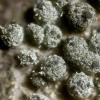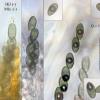
02-12-2025 18:59
This pair of ascos 2.5cm across were on recently b

02-12-2025 19:25
Buckwheat PeteHello, can anyone identify this hairy fungus growi

30-11-2025 12:53
 Edvin Johannesen
Edvin Johannesen
White short-stipitate apothecia found on thin twig

30-11-2025 10:47
 William Slosse
William Slosse
I recently found a collection of small Peziza sp.

27-11-2025 12:01
Thomas Læssøehttps://svampe.databasen.org/observations/10496727

27-11-2025 11:46
Thomas Læssøehttps://svampe.databasen.org/observations/10493918

17-09-2025 10:50
Heather MerryleesHi there!I am hoping for any advice on the identif

29-11-2025 08:40
 Andreas Millinger
Andreas Millinger
Hello,on a splintered part of a branch on the grou
Have you some idea about this strange roundish, densely gregarious,
uniperitheciate pyrenomycete, up to 0.7-0.8 microns in diam, covered by a
conspicuous white material? It was collected on the underside of a woody piece
(perhaps Salix).
The asci have a little refringent apparatus IKI and Melzer negative and the ascospores
(2-guttulate in H2O) have any germ slit (or it is very inconspicuous).
When I began to study it, my material was very damaged and for it I cannot do a good description but I see any dark peridial setae of Coniochaeta-type
Many thanks again
Enrique

I agree with you this likely a Coniochaeta. They don't all have conspicuous setae, you should check the ostiolar region in a crush mount, you may find small setae.
Regarding a possible species name I have no idea! Maybe Andy?
Good luck!
Jacques
But the spores have not conspicuous germ-slits as the typical Coniochaeta species!
I can't to study more the perithecia because they are dead

Andy

Peter

your species reminds me somewhat of Boliniaceae, especially if you look at the spores on the left site (2guttulate, as you described). Arrangement in Asci is similar to that in C. microspora, for example. Only the apical apparatus does not fit to "Camarops". I do not know Boliniaceae very well but I think you should look there.
regards,
björn

Andy

regards,
björn

Andy
cheers

